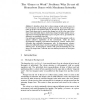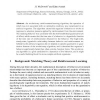12950 search results - page 2458 / 2590 » On Optimal Timed Strategies |
CEEMAS
2005
Springer
14 years 1 months ago
2005
Springer
A honeybee colony has to choose among several nectar sources in the environment, each fluctuating in quality over time. Successful forager bees return to the hive and perform dance...
ECAL
2005
Springer
14 years 1 months ago
2005
Springer
An evolutionary reinforcement-learning algorithm, the operation of which was not associated with an optimality condition, was instantiated in an artificial organism. The algorithm ...
GECCO
2005
Springer
14 years 1 months ago
2005
Springer
Computationally identifying transcription factor binding sites in the promoter regions of genes is an important problem in computational biology and has been under intensive resea...
ASPLOS
2004
ACM
14 years 1 months ago
2004
ACM
Maintenance is the dominant source of downtime at high availability sites. Unfortunately, the dominant mechanism for reducing this downtime, cluster rolling upgrade, has two short...
CF
2004
ACM
14 years 1 months ago
2004
ACM
Current instruction fetch policies in SMT processors are oriented towards optimization of overall throughput and/or fairness. However, they provide no control over how individual ...


